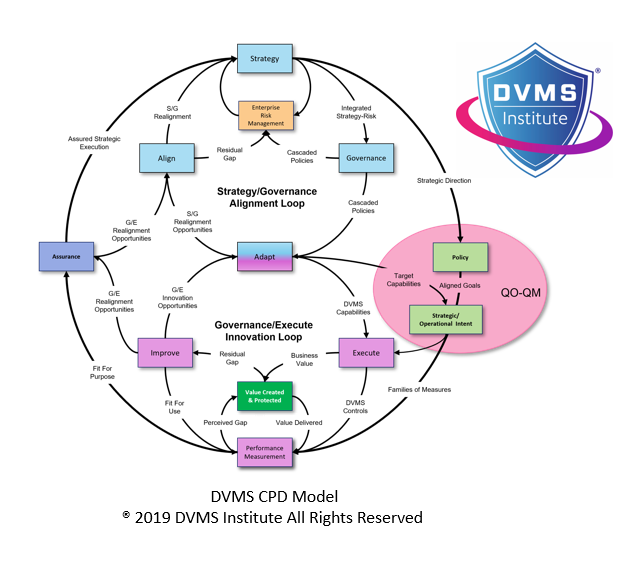The Evolution of GRC: From Prescriptive Rules to Dynamic Oversight Rooted in Outcomes, Resilience, and Accountability
Rick Lemieux – Co-Founder and Chief Product Officer of the DVMS Institute
Introduction: The Disruption of Traditional GRC Models
The Governance, Risk, and Compliance (GRC) market is transforming profoundly. Once dominated by rigid, checklist-based compliance programs designed to enforce prescriptive rules, GRC is shifting toward dynamic oversight that prioritizes business outcomes, operational resilience, and cultural accountability. This change has been driven by the growing complexity of digital ecosystems, the pace of innovation, the unpredictability of cyber threats, and an emerging understanding that compliance alone does not guarantee protection, value, or trust. In short, modern organizations no longer ask, “Are we compliant?” but instead, “Are we resilient, adaptive, and accountable in the face of uncertainty?”
The Limitations of Rule-Based Compliance
Regulatory and standards-based compliance efforts have shaped how organizations manage risk for decades. This approach was straightforward: regulators or industry bodies defined requirements, and organizations built programs to ensure those requirements were met. The absence of findings defined audits, which measured conformance and success. While effective in creating baseline protections and controls, this static, rule-bound model has significant limitations.
First, prescriptive rules are often reactive. They emerge in response to known incidents and take time to develop, approve, and implement. When organizations adjust their systems and policies to new mandates, threat actors may have already moved on to exploit new attack surfaces. Second, compliance efforts can encourage a “check-the-box” mentality, where meeting the minimum requirement becomes the primary objective, rather than understanding and addressing the actual risk. Finally, prescriptive compliance fails to scale effectively in complex, fast-changing digital environments. With global operations, hybrid cloud infrastructure, and extended supply chains, rigid rules become difficult to implement and insufficient for assurance.
The Shift Toward Outcome-Focused Adaptive Governance
In response, the GRC market is evolving toward a new paradigm that emphasizes outcomes over process. This change is best illustrated by frameworks such as the NIST Cybersecurity Framework (CSF) 2.0, which moves away from control-centric mandates and provides guidance centered on cybersecurity outcomes. Rather than prescribing how organizations must operate, it defines what they must achieve: strong adaptive governance, visibility into risk, protection of critical assets, detection of anomalies, effective incident response, and recovery capabilities.
This outcome-oriented approach allows organizations to tailor their risk strategies to their specific mission, context, and risk appetite. It acknowledges that different organizations will take different paths to achieve the same result due to size, sector, or operational complexity. This flexibility fosters innovation and encourages the use of emerging tools, methods, and practices to meet real-world demands better.
Resilience as a Strategic Imperative
The outcome-driven GRC model naturally leads to a greater emphasis on resilience. Where compliance focuses on preventing failure through controls, resilience is about ensuring continuity and recovery when failure inevitably occurs. In today’s volatile, uncertain, complex, and ambiguous (VUCA) environment, threats are too diverse and dynamic to prevent entirely. Ransomware attacks, supply chain disruptions, data breaches, and geopolitical instability require organizations to defend, adapt, and rebound.
Resilience becomes the actual test of an organization’s GRC capability. Are its systems redundant and recoverable? Is there clarity around decision-making during crises? Are roles and responsibilities clearly defined at every level—from the boardroom to the front lines? Is the organization continuously learning from incidents to improve its posture? These questions go far beyond what traditional compliance models measure. Resilience requires a systems-level view of the organization, linking governance to strategy and operations, and treating cybersecurity as a byproduct of value protection and quality assurance.
The Rise of Accountability and Cultural Change
Another defining feature of the shift in GRC is a growing emphasis on accountability. In the traditional model, responsibility for compliance was often siloed within risk, audit, or IT departments. But today’s threat landscape has made it clear that everyone—from executive leadership to third-party vendors—plays a role in managing digital and operational risk.
Modern GRC practices focus on embedding accountability across the organization. This requires cultural change. Leaders must model risk-aware behaviors, communicate transparently, and reinforce expectations through incentives and structure. Employees must be empowered to make risk-informed decisions and feel responsible for protecting organizational value. Furthermore, cultural norms—how people talk about risk, how failure is perceived, how learning is encouraged—are being recognized as core levers in building organizational resilience.
This cultural aspect of GRC is now being codified in models such as the Digital Value Management System® (DVMS) from the DVMS Institute, which positions accountability, governance, and culture as interdependent components of a resilient organization. In DVMS, culture is not an abstract concept—it is a system of behaviors, symbols, and routines that either support or inhibit strategic objectives. Accountability is achieved by aligning policy with practice and measuring outcomes, not just adherence.
Technology, Agility, and Real-Time Risk Management
Another factor fueling the evolution of GRC is the rise of real-time technology. Organizations now have access to advanced data analytics, AI, and automation, enabling continuous monitoring of risks, anomalies, and performance indicators. These technologies allow for proactive rather than reactive GRC, making it possible to spot emerging risks, assess the effectiveness of controls, and take corrective action before issues escalate.
Moreover, organizations are adopting agile GRC approaches that align with digital transformation. Rather than long planning cycles and static audits, agile GRC is iterative, focused on rapid feedback, cross-functional collaboration, and constant reassessment of priorities. This aligns well with dynamic oversight, where governance mechanisms are not rigid structures but adaptive systems that evolve based on input, context, and outcomes.
The Regulatory Landscape is Adapting Too
Interestingly, regulatory bodies themselves are beginning to embrace the shift toward outcomes-based regulation. Rather than mandating specific technical controls, regulators increasingly ask organizations to demonstrate effectiveness. In cybersecurity, privacy, ESG (Environmental, Social, Governance), and other areas, compliance is being redefined as the ability to show that systems, behaviors, and cultures are achieving the intended results—protecting stakeholder value, ensuring ethical conduct, and enabling long-term sustainability.
This regulatory evolution supports the GRC transition by allowing organizations to align risk practices more closely with their business objectives and values. It also opens the door for innovation in how governance is structured, risk is reported, and assurance is obtained.
Conclusion: Toward Adaptive, Integrated, and Value-Driven GRC
The movement from prescriptive rules to dynamic oversight marks a paradigm shift in the GRC market. It reflects the reality that digital risk is not static, that compliance is not protection, and resilience is the only viable strategy for long-term success. This transformation aligns GRC more closely with how modern organizations operate—through complex systems, interdependent teams, rapid change, and the need for continuous value creation and protection.
GRC is no longer just about reducing risk. It is about enabling performance, building trust, and ensuring accountability in a world where the only constant is change. By focusing on outcomes, embedding resilience, and cultivating a culture of accountability, organizations can meet their regulatory obligations and thrive at the edge of uncertainty.
In the digital era, dynamic oversight isn’t just the future of GRC—it’s already the present. Those who embrace it will define the standards of trust, agility, and excellence for years.
About the Author

Rick Lemieux
Co-Founder and Chief Product Officer of the DVMS Institute
Rick has 40+ years of passion and experience creating solutions to give organizations a competitive edge in their service markets. In 2015, Rick was identified as one of the top five IT Entrepreneurs in the State of Rhode Island by the TECH 10 awards for developing innovative training and mentoring solutions for boards, senior executives, and operational stakeholders.
In today’s digitally driven economy, cyber disruptions are no longer an “if” but a “when.”
The DVMS Institute’s Certified Training Programs teach organizations the skills to build a Holistic and Culture-Aligned Overlay System capable of coordinating Cyber Operational Resilience actions across a Complex Digital Ecosystem.
Achieving true cyber operational resilience requires seamless alignment between organizational Strategy, Governance, and Operations, underpinned by a culture dedicated to sustaining and continuously innovating the Creation, Protection And Delivery of organizational digital value.

The DVMS positions cyber resilience as a strategic, enterprise-wide capability powered by your best practice systems (NISTCSF, ITSM, GRC) and the DVMS MVC, CPD, and 3D Knowledge models.
This systems-based approach to cyber operational resilience demands active engagement from all members of the Digital Ecosystem. Each member plays a distinct role in proactively identifying and mitigating the systemic risks that threaten digital business operations.
This forward-looking approach to adaptive Governance, Resilience, and Assurance (GRA) positions businesses to:
- Maintain Operational Stability Amidst Constant Digital Disruption
- Drive Agility and Trust Across Your Digital Ecosystem
- Satisfy Critical Regulatory and Certification Requirements
- Leverage Cyber Resilience as a Competitive Advantage
DVMS Explainer Videos
- Architecture Video: David Moskowitz explains the DVMS System
- Case Study Video: Dr. Joseph Baugh Shares His DVMS Story.
- Overlay Model – What is an Overlay Model
- ZX Model – The MVC’s that power operational resilience
- CPD Model – Adaptable governance and assurance
- 3D Knowledge Model – Enabling holistic organizational learning
- FastTrack Model – A phased approach to cyber resilience
Digital Value Management System® is a registered trademark of the DVMS Institute LLC.
® DVMS Institute 2025 All Rights Reserved



